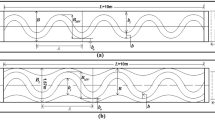Abstract
Rivers in their natural course encounter different slopes, morphology, and physical conditions. Response of rivers adapting to those conditions alters their course, cross-sections, resistance, and other hydraulic properties. Terrains with gentle slope are seen in urban areas, estuaries, etc. In these areas, flow area expands as velocity decreased and become a non-prismatic diverging compound section. When river flow enters its floodplain, the flow structure is influenced by momentum exchanges between subsections. Due to the velocity difference between the main channel and the floodplain, eddies will generate at interface, making flow complex. Hence, velocity distribution is one of the primary interests of river engineers because of its importance in many engineering applications. Effect on hydraulic parameters under the influence of both bed roughness and channel geometric properties is one of the complex situations to prepare analytical models. In this study, velocity is measured in both smooth bed (Perspex sheet) and rough bed (gravel bed) using Micro ADV. Experiments are designed to understand the flow behavior in transition in flume and roughness of bed and interaction between both. Computational fluid dynamics is a prominent technique which is widely used by researchers among the world for its ability in reproducing the physics of flow. Numerical modeling is carried out using Ansys Fluent software. Numerical model results helped in the better understanding of flow structure with better visualization methods. It is known that numerical simulations are susceptible to error due to coarse mesh size, so mesh convergence studies are conducted to produce grid-independent results, and the velocity predicted from numerical simulation tends to be precise with mean absolute percentage error (MAPE) of 3.96%. It can be concluded that numerical simulations gave accurate results in predicting the pattern and magnitude of velocity.











Similar content being viewed by others

References
Abbaspour A, Kia SH (2014) Numerical investigation of turbulent open channel flow with semi-cylindrical rough beds. KSCE J Civil Eng 18(7):2252–2260. https://doi.org/10.1007/s12205-014-0301-0
Alawadi WAAK (2019) Velocity distribution prediction in rectangular and compound channels under smooth and rough flow conditions. Science and Engineering University of Salford, Salford, UK
ANSYS (2013) Fluent Theory Guide. ANSYS Inc, USA Available at: http://www.afs.enea.it/project/neptunius/docs/fluent/html/th/main_pre.htm
Asnaashari A et al (2016) Experimental and numerical investigation of the flow field in the gradual transition of rectangular to trapezoidal open channels. Eng Appl Comp Fluid Mech 10(1):272–282. https://doi.org/10.1080/19942060.2016.1149102
Bousmar D (2002) Flow modelling in compound channels : momentum transfer between main channel and prismatic or non-prismatic floodplains. Université catholique de Louvain Available at: http://hdl.handle.net/2078.1/4996
Bousmar D, Zech Y (2004) Velocity distribution in non-prismatic compound channels. Proc Inst Civil Eng: Water Manag 157(2):99–108. https://doi.org/10.1680/wama.2004.157.2.99
Das BS, Devi K, Proust S, Khatua KK (2018) Flow distribution in diverging compound channels using improved independent subsection method. In River Flow 2018: 9th International Conference on Fluvial Hydraulics (Vol. 40, No. 05068), pp 8
Fattahi Nafchi R et al (2022) Investigation on the effect of inclined crest step pool on scouring protection in erodible river beds. Nat Hazards 110(3):1495–1505. https://doi.org/10.1007/s11069-021-04999-w
Gandhi BK, Verma HK, Abraham B (2010) Investigation of flow profile in open channels using CFD, in Ighem 2010. Roorkee, India, pp 243–251. Available at: http://www.ighem.org/Paper2010/TSF02.pdf
Ghashghaie M, Eslami H, Ostad-Ali-Askari K (2022) Applications of time series analysis to investigate components of Madiyan-rood river water quality. Appl Water Sci 12(8):1–14. https://doi.org/10.1007/s13201-022-01693-5
Jing H et al (2008) ‘Three-dimensional numerical simulation of compound meandering open channel flow by Reynolds stress model’. Int J Numeric Methods in Fluids 59:927–943. https://doi.org/10.1002/fld
Knight, D. W., Wright, N. G. and Morvan, H. (2005) Guidelines for applying commercial CFD software to open channel flow. Available at: http://www.nottingham.ac.uk/cfd/ocf/guidelines.pdf
Li F et al (2021) Flow depth, velocity, and sediment motions in a straight widened channel with vegetated floodplains. Environ Fluid Mech 21(2):483–501. https://doi.org/10.1007/s10652-021-09783-9
Naik B et al (2018) Numerical modeling of converging compound channel flow. ISH J Hydrau Eng 24(3):285–297. https://doi.org/10.1080/09715010.2017.1369180
Rahim AS et al (2022) Flow structures in asymmetric compound channels with emergent vegetation on divergent floodplain. Acta Geophysica 70(5):2403–2421. https://doi.org/10.1007/s11600-022-00764-0
Ramamurthy AS, Han SS, Biron PM (2013) Three-dimensional simulation parameters for 90° open channel bend flows. J Comp Civil Eng 27(3):282–291. https://doi.org/10.1061/(asce)cp.1943-5487.0000209
Rameshwaran P, Naden PS (2003) Three-dimensional numerical simulation of compound channel flows. J Hydrau Eng 129(8):645–652. https://doi.org/10.1061/(asce)0733-9429(2003)129:8(645)
Rezaei B, Amiri H (2018) Numerical modelling of flow field in compound channels with non-prismatic floodplains. Scientia Iranica 25(5A):2413–2424. https://doi.org/10.24200/sci.2017.4215
Rezaei B, Knight DW (2011) Overbank flow in compound channels with nonprismatic floodplains. J Hydrau Eng 137(8):815–824. https://doi.org/10.1061/(asce)hy.1943-7900.0000368
Satheesh Kumar A, Singh A, Thiagarajan KB (2020) Simulation of backward facing step flow using OpenFOAM®. AIP Conf Proc 2204. https://doi.org/10.1063/1.5141565
Yonesi HA, Omid MH, Ayyoubzadeh SA (2013) The hydraulics of flow in non-prismatic compound channels. J Civil Eng Urban 3(6):342–356
Author information
Authors and Affiliations
Corresponding author
Ethics declarations
Conflict of interest
The authors declare no competing interests.
Additional information
Responsible Editor: Broder J. Merkel
Rights and permissions
Springer Nature or its licensor (e.g. a society or other partner) holds exclusive rights to this article under a publishing agreement with the author(s) or other rightsholder(s); author self-archiving of the accepted manuscript version of this article is solely governed by the terms of such publishing agreement and applicable law.
About this article
Cite this article
Bodapati, S.S.P., Pinakana, L.R., Khatua, K.K. et al. Effect of roughness on velocity distribution in diverging compound channels using experimental and numerical approaches. Arab J Geosci 16, 200 (2023). https://doi.org/10.1007/s12517-023-11281-9
Received:
Accepted:
Published:
DOI: https://doi.org/10.1007/s12517-023-11281-9



